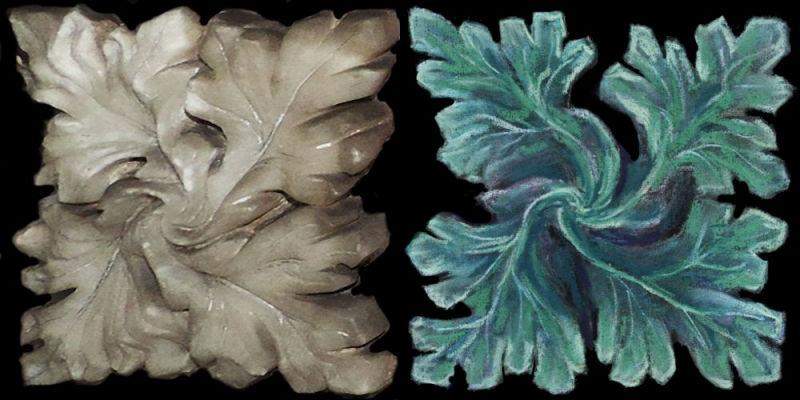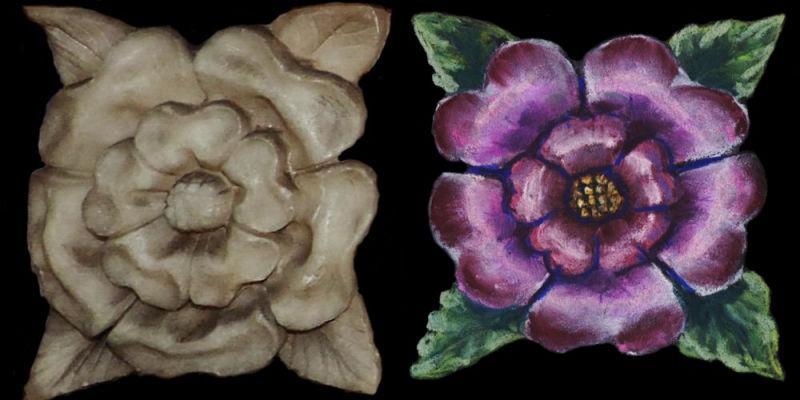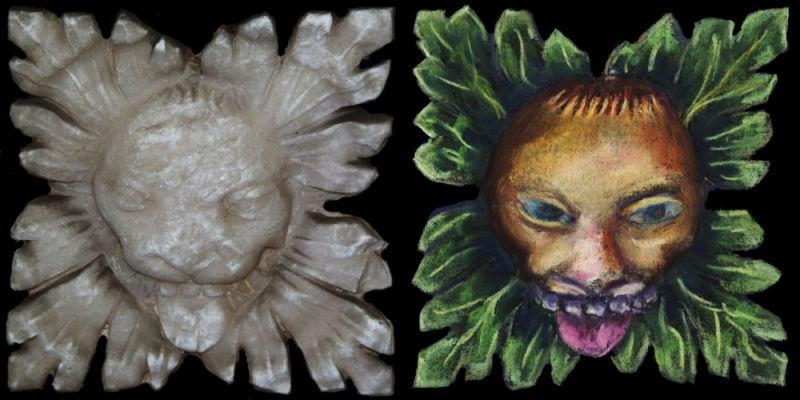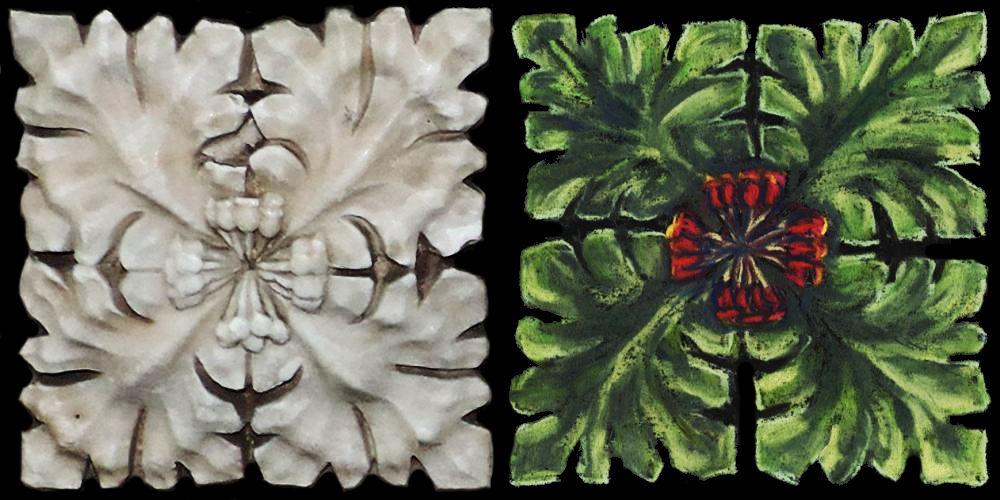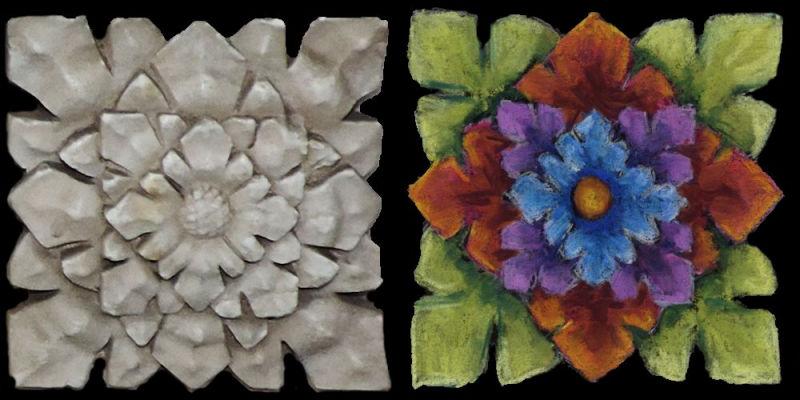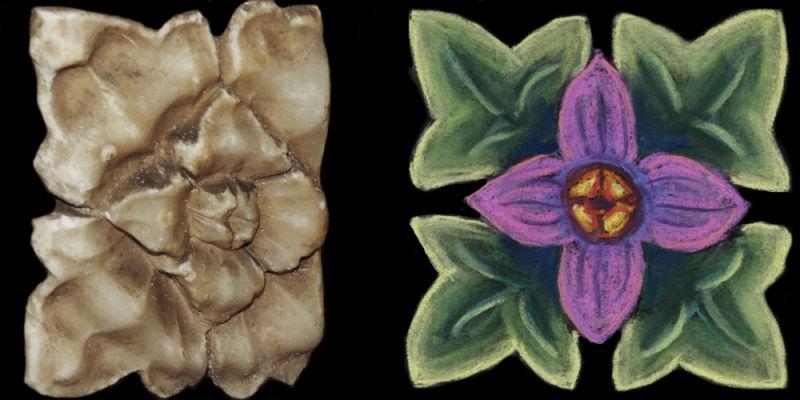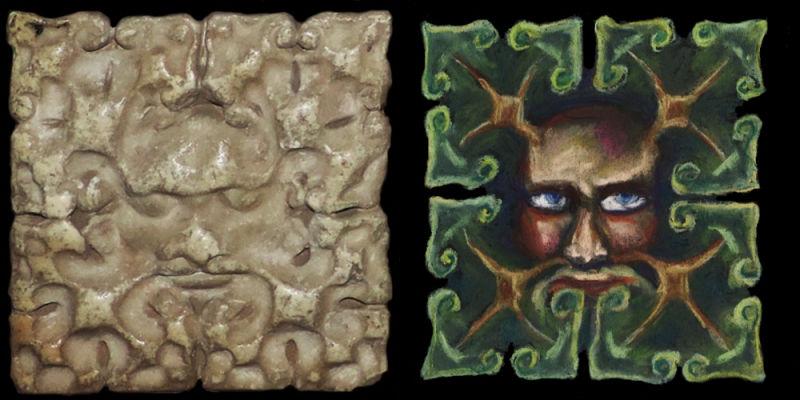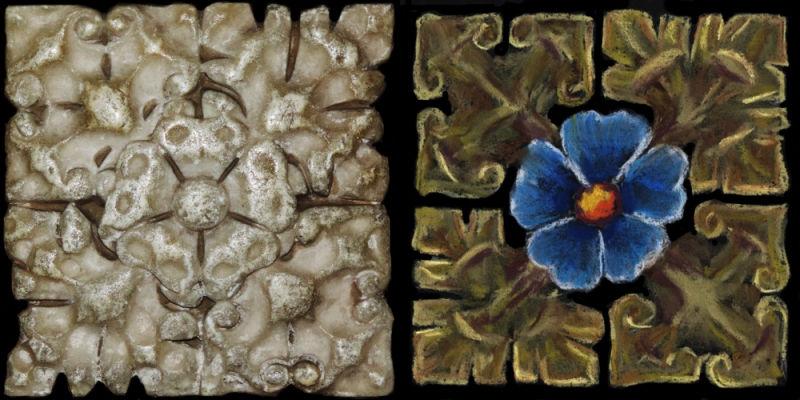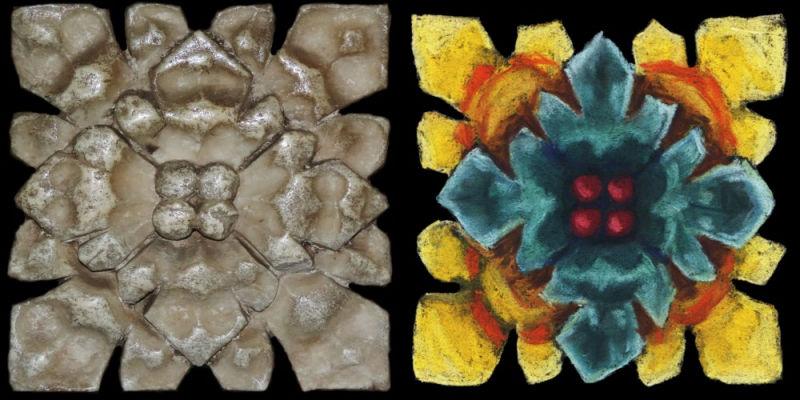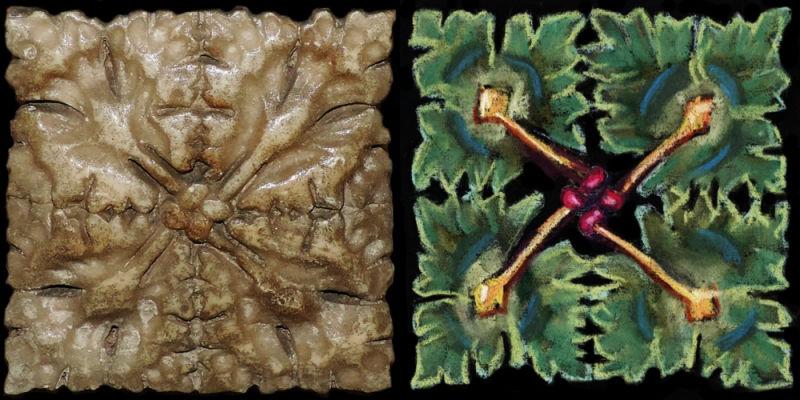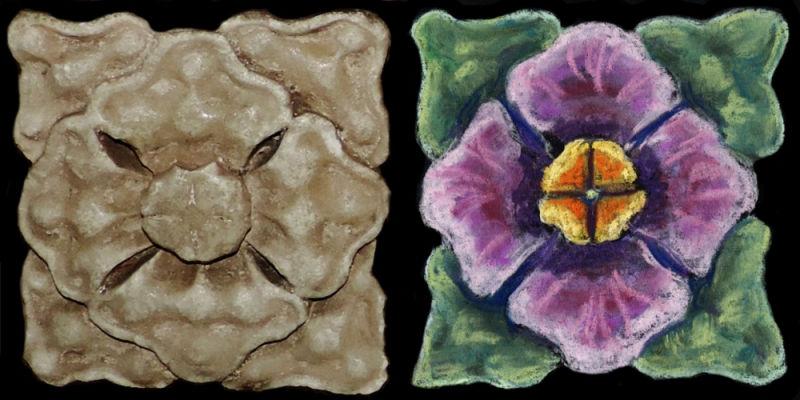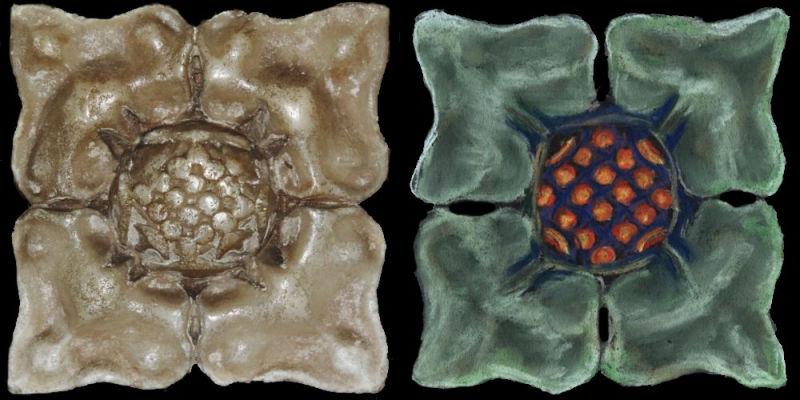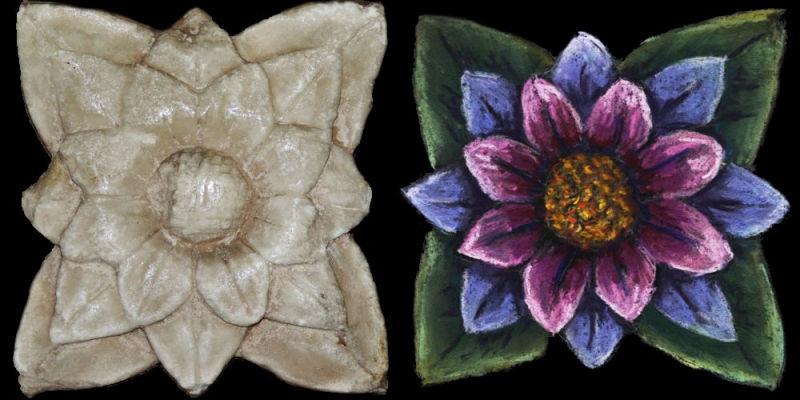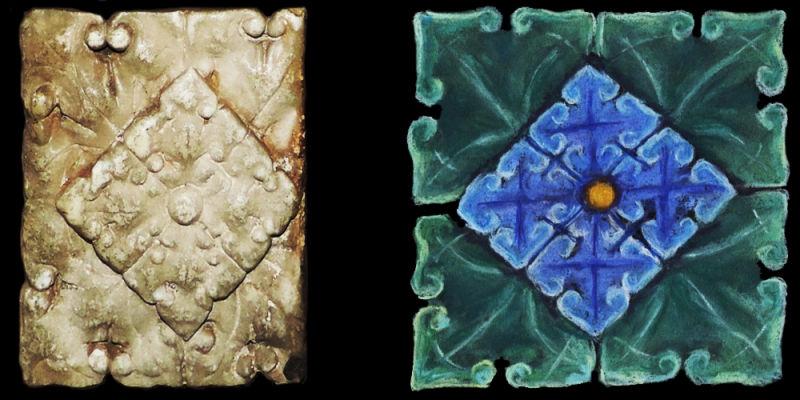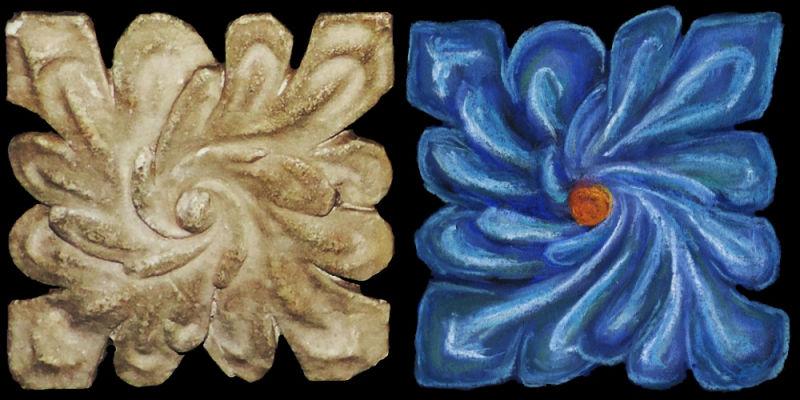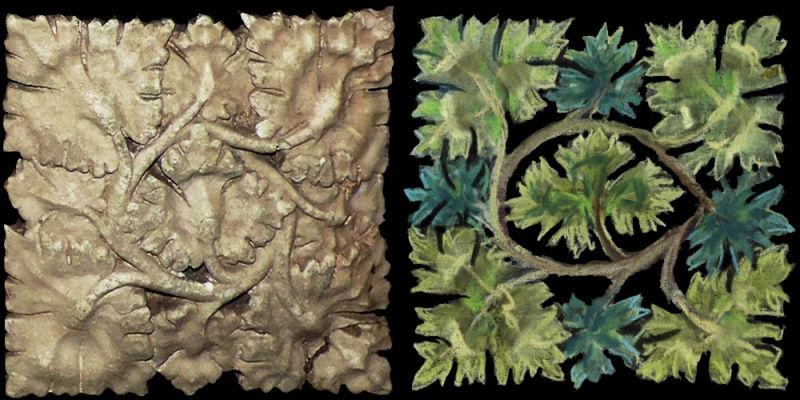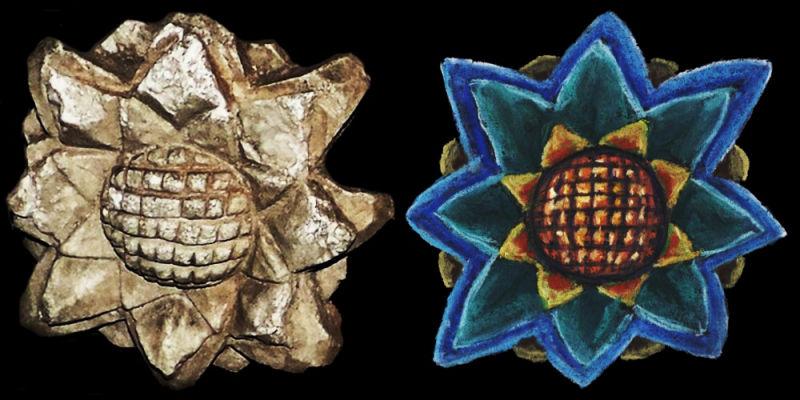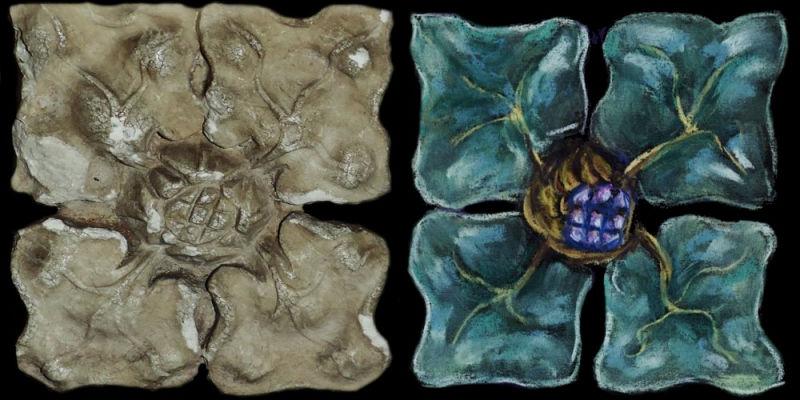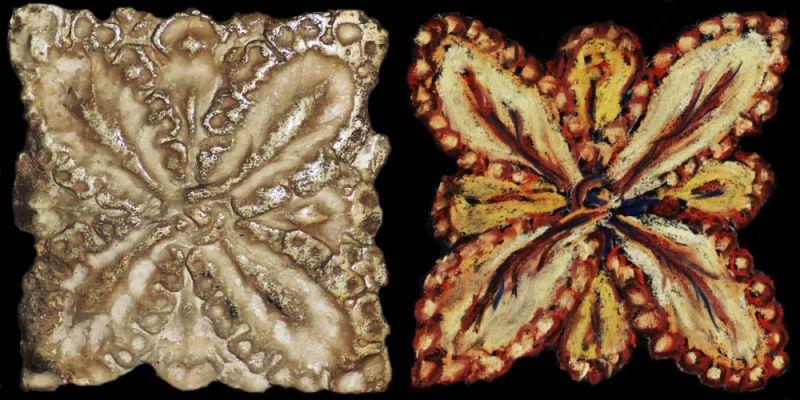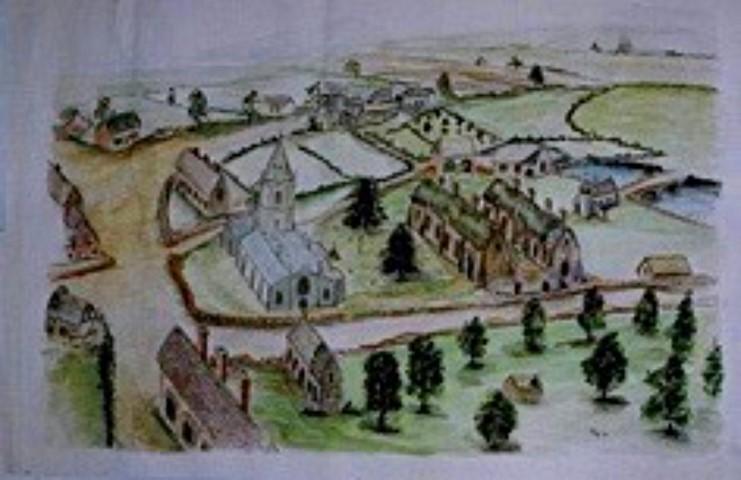
St Bartholomew’s, Tong
The Foundress Tomb
St Bartholomew’s, Tong
The Tomb of Sir Fulk Pembrugge IV and Dame Isabel Lingen
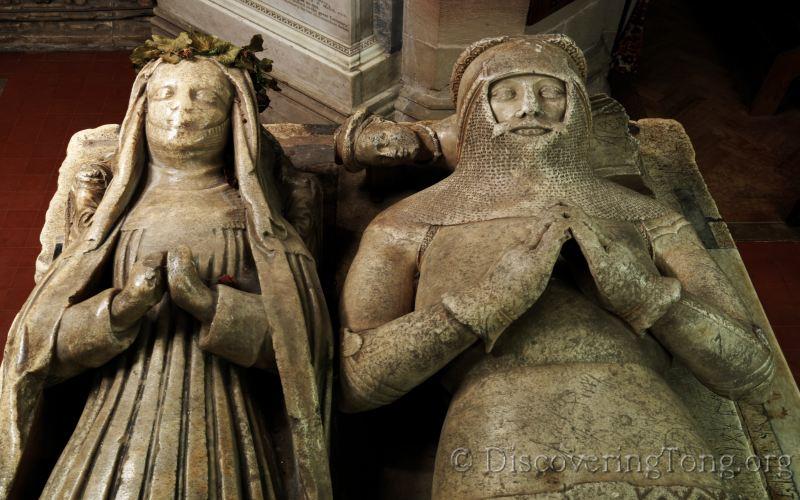
The oldest tomb in Tong church is that of Sir Fulke Pembrugge IV (1343-1409) and his wife Lady Isabel (c.1370-1446)10 (pp. 21-22). This report looks at the background to the building of the tomb in Tong church and then the tomb’s decorations in detail. There is a list of references at the end.
The foundation of Tong Church (c.1410)
Very little is known about the building of the current church. All we have in writing is the legal document signed in November 1409 which permitted Dame Isabel de Pembrugge to set up a collegiate church at Tong. It is likely that the church and college would have taken over ten years to build, 1409 is the date when the legal niceties were signed off. One source claims it was completed in 14251.
Tong in 1400
The Pembrugge family had become Lords of Tong in about 1270 and had built a substantial castle with courtyard, keep and its own chapel18. At the time of the Peasant’s Revolt in 1381 the castle increased its defences. Prior to the 13th century Tong had been just another small possession of absent land owners while for the period 1270-1650 it became the main residence of a powerful regional lord. We know that a church was built or re-built in 1087 by the Earl of Montgomery. By 1400 this may have been in a dilapidated state and so a factor in rebuilding the church in 1410. To establish a collegiate church Dame Isabel bought the advowson from Shrewsbury Abbey so that the church and college were under the control of the lords of the manor at Tong rather than the then Catholic church.
At this time land ownership had broken down into small parcels, typically parishes, an aim of any ambitious owner was to marry children to neighbouring land owning families to build up larger parcels of land. These landowning families battled with the Welsh to keep the border area in English hands in the years after the Norman Conquest. The Mortimer family from their castle at Wigmore, Herefordshire became the Earls of the March and married into the English royal family. The Mortimers were one of the most powerful families at this time and had free rein in governing the Welsh border lands that included Shropshire and Tong 28. The power of the Marcher lords lasted into the early 16th century. Both the Lingen and Pembrugge families had their original home near to Wigmore, the move to Tong will have taken them away from some of the upheavals in that area. It was only after about 1400 that frequent skirmishes and rebellions died down and castles no longer needed fortifications. Shropshire was at the heart of English politics at the time. Richard II held the English parliament in January 1398 at Shrewsbury and the rebellion of Henry ‘Hotspur’ Percy, supported by the Mortimers against Henry IV came to its conclusion at the Battle of Shrewsbury on 21st July 1403. The village of Tong was on the important Worcester to Chester road and not some sleepy backwater, with a large castle at Tong it must have been an important staging post. https://www.google.com/maps/d/embed?mid=1krM8PiLVmxIVMRES5wt9WZmtz1ex-0Vz
A map of all the locations is given in the map to the left. To understand the circumstances of the foundation it is useful to look at the leading families involved with Tong. In trying to trace the family trees a few errors in the published information have been uncovered but other mysteries remain.
The Pembrugge family
The village of Pembridge in north Herefordshire was the home to the de Pembrugge (or Pembridge) family who had risen in prominence since the Norman Conquest. Pembridge is close to the Welsh border an area of conflict at this time.27
The interior of St Mary’s church, Pembridge, Herefordshire.
Available under a Creative Commons licence.
The Lingen family
The Lingen family to which the Pembrugges intermarried came from the village of Lingen near Wigmore close to Pembridge. The family line continued after the time Dame Isabel with Sir Ralph Lingen, her brother. The Lingens were sheriffs of Herefordshire in the 16th century17. Nearby Wigmore castle was the ancestral home to the Mortimer family, Earls of the March, who led a rebellion culminating in the Battle of Shrewsbury 140326. It is unlikely that the Lingens were not involved in some way with the rebellion. Sir John Lingen fought on the winning Yorkist side at the Battle of Mortimer Cross, Herefordshire in 146115.
St Michael and All Angels Church, Lingen, Herefordshire.
View east from the entrance to this beautiful church, with plenty of snowdrops in the churchyard. The church dates from the 13th century but the original building fell into disrepair, to be replaced by a new church about the reign of James II, much of the old masonry being kept.
Available under a Creative Commons licence.
The Vernon family
The Vernons originate from the town of Vernon of the banks of the River Seine in Normandy. They accompanied William on his conquest of 1066 and prospered in England. A number of branches of the Vernon family became established in Britain21. The branch associated with Tong come from Haddon, Derbyshire and the Vernon descendents (now Manners) still live atHaddon Hall, near Bakewell. They moved from Haddon to Tong in the 15th century, when Sir Henry Vernon re-built much of Haddon Hall (c.1510) then that became their main residence again.
Church of Notre Dame de Vernon, Vernon, Eure, France.
Available under a Creative Commons licence.
The Ludlow family
The Pembrugges intermarried with the de Ludlowe family. There is little known about their early origin, the ‘de Ludlow’ may merely mean they originated from the town of Ludlow. At the time of Lady Isabel they had become a major player in Shropshire and the branch of interest owned Stokesay and Hodnet. Sir Richard Ludlow ➚ (c.1350-90) was Member of Parliament for Shropshire 1388-90; his estates passed to his brother Sir John (c.1365-98), Isabel’s second husband on his death without an heir. Ownership of Stokesay then passed to the Vernons by marriage.
The Trussell family
The Trussells prospered in the 14th century. They began at Kibblestone (between Stone and Stoke-on-Trent) but soon owned many parcels of land including Shottesbrooke near Reading, Sherrifhales and Weston-under-lizard. There is some evidence to suggest a connection to Robin Hood – a daughter of Robin of Loxley married a William Trussell12. Sir Fulke Pembrugge married Margaret Trussell to consolidate land ownership in Shropshire as she held land at Weston-under-Lizard and Hodnet. Unfortunately they had no children and disputes about the ownership Trussell estates dragged on for a long time after his death. When Margaret died the true heir Sir William Trussell was only 10 years old and so Sir Fulke held the lands for him. After this period Sir Richard Vernon (1398-1457) seized the Shottesbrooke estate and laid claim to all the other Trussell lands. In 1442 the court’s judgement went against Sir Richard and he was due to pay damages of 120 marks. In 1446 Sir Richard appealed and won the case by allegedly bribing the jury. Then Sir William Trussell (c.1385-1464) appealed but lost on the basis that Sir Richard claimed that William had forged some of the papers and William was fined an enormous sum of 2,080 pounds (multiply by may be 1,000 to get today’s value)12 (pp. 23-24). However on Sir Richard’s death in 1451 the heat went out of the fight and Sir William Trussell inherited the lands he was due after twenty years or more of disputes 24.
The key influence of the Trussells on Tong was that they built a collegiate church at Shottesbrooke and Dame Isabel used the style of foundation as a blueprint for the new Tong church and college. Margaret Trussell is buried at Shottesbrooke rather than with her husband at Tong.
Dame Isabel Lingen (c.1370-1446)
The foundress of the present church lived to around 76 years old which was a remarkable achievement for the time. She out-lived her daughter Benedicta. We don’t know her exact year of birth but she was married a second time and had a daughter in 1396 suggesting she would have been born around 1370. She was born at Hodnet, Market Drayton, Shropshire 6 but her mother was Margery de Pembrugge who was born at Tong Castle c. 1345 7. She married three times, firstly to Thomas Petyvyne (or Peytevin) of whom very little is known, secondly to Sir John Ludlowe (1366-98) of Stokesay Castle and Hodnet and on his death to Sir Fulke IV de Pembrugge. The Collegiate church at Tong is dedicated to the memory of all three of her husbands.
Document setting out the foundation of the Collegiate church at Tong, November 1409. Short summary: Isabel late the wife of Fulk de Penbrugge, knight, and Walter Swan and William Mosse, clerks, to acquire the advowson of the church of Tong from the abbot and convent of Shrewsbury, to make the said church into a college of five chaplains, and to endow it with messuages [a dwelling house with outbuildings and land assigned to its use] and land in Tong (Salop) and Sharnford (Leic.), the reversion of the manor of Gilmorton (Leic.), now held by William Neuport and Margaret his wife for the life of the said Margaret, and the advowsons of the churches of Tong (Salop) and Orlingbury (N’hamp.) which may be appropriated, retaining messuages in Tong (Salop) and Aylestone (Leic.). Salop. Leic. N’hamp.
National Archive, Kew. Document C143/442/14/.
She lived in tumultuous times, her life spanned the eventful reigns of Edward III, Richard II, Henry IV, Henry V, Henry VI. and Edward IV. This was the time of the ongoing wars in France and internal rebellions as well as recurrences of the Black Death. It is not surprising that George R. Martin set the Game of Thrones books in this period of feuding fiefdoms (Lancaster=Lannister; York=Stark and so on).
Sir Fulke Pembrugge IV was member of parliament for Shropshire and a crusader knight. He was the tax collector for Shropshire in 1377. He had received plenary remission of sins from the hands of Pope Urban V at Avignon in 1364. He went to Jerusalem and aided the people of the Holy Land against Turkish occupation. For this act he was given an armorial crest of a Saracen’s head with long hair. He only attended parliament once, in September 1397.
The circumstances of the church foundation are that when Sir Fulke IV de Pembrugge died on 24th May 1409 his widow was left with a major problem of succession. There were no surviving children from her marriage to Sir Fulke and none also from his previous marriage to Margaret Trussell who had died in 1399, so there was no male heir to the Pembrugge line. So although Sir Fulke’s Will directed that the lands be held by Isabel for the rest of her lifetime, on Isabel’s death the lands would be split between distant branches of the families.
From her marriage to Sir John Ludlow, Isabel had daughters Benedicta, Margery, Isabel and Alice as well as a son Sir William Ludlow who was heir to the Ludlow estates. To enable her lands to be inherited she married Benedicta into the illustrious Vernon family. Richard Vernon was a grandson of Juliana de Pembrugge (Sir Fulke IV’s sister and Isabel’s aunt) so this kept the Pembrugge’s lands together through the female line. When Sir Fulke died in 1409 Benedicta’s son Richard Vernon was still a minor and did not immediately inherit his grandfather’s lands. To flag his future inheritance he sometimes was given the name Richard Pembrugge to denote this connection (and to complicate matters of identification). By these marriage alliances the Pembrugge lands merged into the Vernon family. At this time Tong Castle was more prestigious than Haddon Hall so the Vernon descendants moved in to become Lords of Tong on Isabell’s death. There was a double marriage between the Ludlows and Vernons. Benedicta de Ludlow married Richard Vernon (1394-1451) and her brother, William de Ludlow (1397-1478), married Joanna de Vernon (1395-1432) Richard’s sister. This William de Ludlow was a major player in the local area – Sheriff of Shropshire (1423-1447) and Member of Parliament 1420-1469.
Isabel’s daughter Margery was married to Sir William Trussell MP (c.1385-1464) the heir to the Trussell estates. Another daughter Isabel de Ludlow married Nicholas Fitzherbert (1410-73) of Norbury, Derbyshire; while a fourth daughter Alice de Ludlow married Richard de la Bere (c. 1390-1422).
Lands controlled by Lady Isabel
The combination of Pembrugge, Harcourt and Trussell lands made her wealthy and influential. At this time the loss of northern France in the Hundred Years War (1337-1453) had caused many Norman lords to lose substantial estates on the continent, so grabbing land in England became important.
Some of the Pembrugge and Lingen lands included: Aylestone, Leicestershire; Greete, Herefordshire; Gillow, Herefordshire and Haselbach, Northamptonshire 20.
Lands providing income for Tong College: Orlingbury, Northamptonshire; Sharnford, Leicestershire; Guilden Morden, Cambridgeshire. Lapley priory was bought in 1415 to provide income to support Tong College as well as Silvington (hamlet near Titterstone Clee Hill).
Lands claimed from the Trussell inheritance: Acton Trussell, Staffordshire (repossessed by Trussell heir c. 1460); Part of city of Chester near east gate also village of Delamere, Cheshire; Part of Weston-under-Lizard, Staffordshire; Sherrifhales, Staffordshire; Gilmorton, Leicestershire and Eaton Hastings, Oxfordshire (on the upper Thames near Lechlade) among others23. Margaret Trussell was an heir to the Boteler estate (Lord of Wem, Shropshire) but I can no find record of these lands being under Dame Isabel’s control.
Lands from the Vernon family under Isabel’s control while Sir Richard a minor: Ullingswick, Herefordshire; Haddon, Derbyshire; Harlaston, Staffordshire and Pitchcott, Buckinghamshire3.
At the time of Sir Fulke’s death in 1409 he possessed estates in nine counties, which were then valued at £127 a year (and in addition substantial income from Buckinghamshire and Chester properties) and these were controlled by Dame Isabel for the next 37 years. The decoration of Dame Isabel’s effigy suggests she served at the court of King Richard II (r.1377-1399) 10(p. 85)
The Pembrugge family mystery
The following revised family tree shows the main members of the Pembrugge family after they became lords of Tong.
The family tree as printed in Robert’s book 10(p. 22) can not be correct as it has Robert Pembrugge dying in 1350 before his son Sir Fulke IV is born in 1363. Records of this date are fragmentary and the custom of using the same first name as your father was prevalent which can add to confusion. Griffiths8is not very reliable on dates like this, he was not a historian. Auden’s notes 1 do not go back as far as this period, on page 10-11 is a brief family tree taken from Eyton3. However some recent digging by Pembrugge descendants seems to have firmed up the dates from various records. They suggest Sir Fulke IV (Sir Fulk Pembridge) was born in about 1343 and married Margaret Trussell in 1363 (aged 20) so that fits in with the life span of Robert Pembrugge. As Margaret Trussell lived until 1399 he could not have married Isabel before 1400 when he would have been about 57 years old and she would have been about 30 years old. In these days after the Black Death (1349) life was perilous, and the fatal disease continued to rumble on with smaller outbreaks (1361, 1369, 1430) ; everyone will have seen how death could strike out a whole family. As an insurance policy many families had several inter-marriages so that if one should die a brother or cousin would inherit the lands and keep them all intact. So the land owning families were all heavily interrelated. Fulk’s sister Margery Pembrugge married Isabel’s brother Ralph Lingen adding a further connection. Even eminent historians have sometimes managed to confuse the family trees as they often had the same first name (Fulk, Richard, Isabel).
Another possibility could be that Sir Fulke IV had a father who died young, this father would need to have been born after 1325 and had a son by 1343 and then died before 1363. This is not impossible but there is no evidence to support this conjecture. It makes more sense for Isabel to have married her uncle in about 1400 in an effort to keep the Pembrugge inheritance safe while Sir Richard Vernon was still a minor. Marrying your uncle seems shocking nowadays but the law that forbade such a union only came into existence in 1560. The ecclesiastical law did forbid such an ‘avuncular’ marriage but royal as well as rich families could receive a dispensation from the Pope to permit it. In the days of the Black Death such a marriage may not have been uncommon. Although it is conceivable that the family trees are incorrect the marriage of Isabel and Sir Fulk does fit the fact of Isabel’s actions to try to maintain the Pembrugge inheritance, if she was not herself of Pembrugge ancestry this would seem unlikely.
The missing Richard Vernon
There is yet another problem with the printed family tree 10(p. 22) but this time on the Vernon side as it has Juliana Pembrugge (1349-1409) marrying Richard Vernon of Harlaston with son Richard Vernon (1398-1457) this has Juliana giving birth aged 50 which would have been impossible. It would also have Benedicta de Ludlow as a generation adrift to her husband Richard. According to Eyton and supported by genealogy sites the missing person is Juliana’s son Richard Vernon (1370-1400) who married Joan Verch Rhys (1369-1412). Joan Rhys was the daughter of Rhys ap Gruffydd ➚ (1334-1385) and Isabel de Stackpole (1345-1371), Pembrokeshire. This suggests a marriage alliance with Welsh nobility. With the Owain Glyndwr rebellion at this time it may suggest a rebel alliance. With at least five ‘Richard Vernons’ in the family tree it is easy to see how these have been confused.
Shottesbrooke Collegiate Church
The idea for a collegiate church came from Sir Fulk’s first wife Magaret Trussell. She was the only surviving daughter of Sir William Trussell (c. 1306-1363) who in 1337 built a collegiate church at Shottesbrooke. Sir William was a favourite of King Edward III and Admiral of the Fleet. He held Odiham Castle ➚, Hampshire where King David II of Scotland was held after prisoner there for a long while 4. The attraction of founding a collegiate church was both financial and spiritual. There were tax advantages to managing land for a church and the clergy were required to pray for the souls of the Lords of the Manor. Isabel will have visited the lovely church at Shottesbrooke and the brass memorial to Sir William Trussell’s daughter Margaret with the college clergy praying for their souls, it must certainly have impressed her.
Brass of Sir Fulk IV Pembrugge’s first wife Margaret Trussell at Shottesbrooke church, Berkshire.
Chaplet of Roses
It seems appropriate to mention here the tradition of the placing a chaplet of roses on Isabel’s effigy. This is a tradition my own mother carried out for some years. In those days it was done unobserved so that the roses appeared as if by magic without any ceremony. I have nothing else to add to Robert’s description which I reproduce here:
“This goes back to a grant of land by Roger la Zouche in 1200. One of the conditions was: ‘Rendering yearly to the said Roger and his heirs a chaplet of roses upon the feast day of the nativity of St John the Baptist in case he or they shall be at Tonge, if not then to be put upon the image of the blessed Virgin in the Church of Tonge.’
So a custom over 200 years old, continued into the new church. But at the Reformation, the statue of Our Lady would have been removed, and so the roses came to the other lady, who was lying near the Lady Chapel. The custom still continues today. Such customs were common practice. In 1316, John de Tong was granted land by Robert de Prees; the rent was a rose on Midsummer’s Day. In 1353 there was a grant by John Byschop of 3 pieces of land at Tong Norton, with a similar arrangement. Another grant was conditional on the exchange of three arrows with goose feathers.”10(p. 86)
The Foundress Tomb mystery
George Griffiths recounts in detail the problem with the tomb of Isabel and Fulk Pembrugge 8(pp. 30-37). Bob Jeffrey’s book does not describe or unravel this mystery. Sir William Dugdale ➚’s description from a visit in 1663 of the base of the tomb analyses the coats of arms that were painted on the shields. These were confirmed in 1982. One of them is for the Vernon family of Tong and Haddon Hall ‘Argent, fretty sable’ and that does not fit either Isabel or Fulk IV who had no Vernon forbears. The same Vernon arms are clearly visible on her son-in-law’s tomb Sir Richard Vernon just across the central crossing. Although the figures on the top of the tomb match Sir Fulk and Lady Isabel it may be that the base of the tomb has been re-used. Griffiths suggests the base originally surrounded a single effigy tomb based on the obvious joints and overall measurements. The arms have been identified as Pembrugge, Vernon, Ludlow and Bermingham. Here are the arms as recorded in Eyton’s account 3(p. 255):
- Blank
- Right side: Barry of six (Pembrugge) impaling a lion Rampant (Ludlow); Left side: Blank
Suggests a man descended from father Pembrugge and mother Ludlow marrying a woman with no family arms. - Barry of six (Pembrugge) impaling Argent Fretty Sable (Vernon)
Suggests a Pembrugge man marrying a Vernon. There is one intriguing internet reference to a Fulk Pembrugge (born c. 1325) marrying a Vernon and having Benedicta Vernon as a daughter but I believe this is confusion of other records9. - Argent Fretty Sable (Vernon)
Suggests a Vernon. - Argent Fretty Sable (Vernon) impaling Barry of six (Pembrugge) Suggests a Vernon man marrying a Pembrugge. Richard Vernon of Harlaston marrying Juliana Pembrugge fits this.
- Same as (4)
- Barry of six Or and Azure (Pembrugge)
Suggests a Pembrugge. - Same as (7)
- Barry of six Or and Azure (Pembrugge) impaling Azure a bend lozenge Or (Bermingham)
Suggests a Pembrugge man marrying a De Bermingham. This fits Fulke II Pembrugge marrying Matilda de Bermingham. - Azure a bend lozenge Or (Bermingham)
Suggests a de Bermingham. - Same as (7)
- Same as (7)
Griffiths solves the conundrum by suggesting that the tomb base was built for another Vernon and then re-used. He thought it must be the tomb for Richard Vernon [1370-1400] of Harlaston, Isabel’s cousin whose son married Benedicta. Griffiths then confuses him with another Sir Richard Vernon who took part in the Owain Glyndwr ➚ rebellion against Henry IV which ended with the Battle of Shrewsbury 21st July 1403. This Sir Richard Vernon together with Thomas Percy, Sir Richard Venables and Sir Henry Boynton were hanged, drawn and quartered at Shrewsbury on 23rd July. He also appears in Shakespeare’s King Henry IV part 1 as 8th Baron of Shipbrook 20. However this Sir Richard is of a distantly related line of Shipbrook Vernons with a different coat of arms to the Vernons of Haddon and Tong and so this is not a solution to the puzzle. However Richard Vernon [1370-1400] of Harlaston is a possibility as he is descended from Vernons, Pembrugges and Berminghams but this does not explain the Ludlow arms. There are apparently no Lingen or Trussell arms on the tomb so this has led Eyton 3, Griffiths and others to speculate. The de Bermingham family arms come in to stand for Sir Fulke IV’s grandmother. As the name suggests the de Bermingham family is associated with the then small town of Birmingham and were Lords of the manor there for hundreds of years 19. The Ludlow and Vernon (Haddon branch) arms combined would only make sense through descendants of Benedicta and Richard Vernon.
Dugdale also reported the coats of arms in the original stained glass windows 3 (p. 257), these included Bermingham, Pype, Vernon, Pembrugge, Lingen, Ludlow, de La Bere and Mortimer.
At the time one could choose any of the arms of forbears, singly or in combination. Any of the descendants of Fulke II could have used Pembrugge and Bermingham arms. It is shield 2 that poses the problem as this would only fit with a child of Benedicta Ludlow and Richard Vernon. Maybe the absence of the Lingen arms is due to the fact that Isabel was not the Lingen heiress? Let us not forget that Isabel was a widow for 47 years so that a tomb to Sir Fulk on his own does not seem unreasonable, especially as the new church and college were built to honour his and her other two husband’s memory. This does not however explain the missing Lingen arms. However there are nine shields for arms on the north and south sides and another five shields on the east and west sides – so 28 in all. Some retain colour but others do not and so the ‘missing’ Lingen arms may have been replaced/obscured/misidentified. Another possibility is that the Lingen family were in disgrace at the time. Another possibility is that the arms would reveal that Dave Isabel married her uncle, perhaps this was something Sir Richard Vernon wished to hide. (Sir Fulke’s arms should be Pembrugge impaling Lingen and Pembrugge).
As her daughter, Benedicta, died two years before her mother a tomb for Isabel’s daughter may have been made which would have Vernon and Pembrugge arms. On Isabel’s death in 1446 may be Sir Richard decided he wanted a grander tomb for himself and Benedicta and so the tomb base made for Richard and Benedicta was adapted for Sir Fulke and Isabel.
Foundress Tomb decorations
Around the top of all four sides of the tomb are heraldic shields interspersed with small decorative squares. This section looks at these square decorations in detail. The tomb is claimed to be the earliest alabaster tomb in Shropshire. Alabaster tombs started to be made in the Nottingham area in the late 14th century. 11(pp. 28-29)5
There are ten decorations on the north and south faces between shields that were painted with armorials of which only a few traces remain. The west face has six decorations but some of the east side is obscured by the wall and only two are visible but it does not seem unreasonable to expect it to be symmetric so there would have originally been 32 (10+10+6+6) decorations in all. Of those visible there are only two designs that are repeated so in total there are in all 26 unique designs. For reference I have referenced them with the compass direction side of the tomb and then the number them from the left (anti-clockwise) so N2 is the second to leftmost square on the north side. I took a series of photographs and manipulated the image only to make them square (except E2 and W1).
North side of the founder’s tomb. A frieze of 10 decorations and 9 shields above rather plain trefoil panelling. Image copyright R.J.L. Smith, Shifnal.
North side decorations.
East side decoration
East side of the founder’s tomb. Four petal flower with inner centre and four tri-lobed leaves. Quite similar to S7 with different petal shapes. The damaged and incomplete east side seems to have been heavily repaired at the junction of the halves for Sir Fulk and Isabel. There is only one image shown here. The only other decoration on the east is a duplicate of the Tudor rose N2.
South side decoration
South side of the founder’s tomb. A similar arrangement to the north side. Image copyright R.J.L. Smith, Shifnal.
Here is a gallery of the decorations along the south side of the founder’s tomb. A similar arrangement to the north side. Image copyright R.J.L. Smith, Shifnal.I include a photograph alongside a rough pastel sketch.
West side decoration
West side of the founder’s tomb. A clear junction between the two halves suggesting the original tomb was re-modelled to accommodate Lady Isabel on her death. The effigies lie on separate plinths. The Vernon arms (Argent Fretty Sable) can be clearly seen on the two shields on the south (Dame Isabel’s side).
Decoration W1 – The right edge is missing – seemingly by design- so may be to accommodate the restricted remaining space along the western edge. The outer design is similar to N8. The inner design is the same as the outer design rotated by 45°.
Summary notes about the decorations
Many of the designs use tri-lobed leaves; these tri-foliate leaves probably represent the Trinity. The simple leaf design is common in early Gothic ornaments25 later on, in Decorated Gothic designs the foliage generally became more accurate renderings of identifiable plants: ivy, maple, oak, acanthus etc..
Green men S1 and S9
The Green Man was not an uncommon subject at the time. I have read Kathleen Basford’s book on ‘The Green Man’ 2 but this does not mention alabaster forms. As the tomb is an early alabaster tomb it may be that these representations are an early and rare representation.
The Lion N4
Although the top half does look like a lion the lower half has a toothy grin with an outstretched tongue. This style of face is common in Green Man representations. I do not know of similar lion decorations.
The Rose N2, E1
One of the designs looks like what came to be the motif of the houses of Lancaster and York in the War 1455-1487. The War of the Roses ➚ began within Isabel’s life time. One reference has Dame Isabel serving at the court of King Richard II 22(pp. 234-235). It would be interesting to see how early this representation is. Some authors say it is a motif of the Blessed Virgin Mary.
The Stallard connection
When researching the Lingen family the author of this report (Robert Stallard) came across a mention of Dr. Andrew Lingen-Stallard (1963-2013). He was a direct descendent of the Lingen family of Lingen and Hodnet through his grandmother who married into the Stallard family15. The Stallard family origins seem to be between around the towns of Hereford and Worcester ➚ and although no kinship with myself has so far been proven, it is a strangely coincidental link between myself and the church at Tong. His coat of arms include the Lingen bars, bend, roses and tincture.
References
- Auden, J. (2005). Auden’s History of Tong. Arima.
- Basford, K. (2019). The Green Man. D.S. Brewer.
- Eyton, R. (1854). Antiquities of Shropshire. John Russell Smith.
- Ford, D. N. (n.d.). Sir William Trussell (d. 1363). Retrieved from Royal Berkshire History: web site ➚
- Gardner, A. (1940). Alabaster Tombs of the Pre-Reformation Period in England.
- Geni. (2019). Lady Isabel Lingen, Lady of Tong. Retrieved from Geni: web site ➚
- Geni. (2015). Margery Mageria de Pembrugge. Retrieved from Geni: web site ➚
- Griffiths, G. (1894). A History of Tong, Shropshire. Horne and Bennion.
- Heritage, M. (n.d.). Fulk Pembrugge. Retrieved 2019, from web site ➚
- Jeffery, R. (2007). Discovering Tong. Parchment Press.
- John Newman, N. P. (2006). Shropshire – Pevsner Architectural Guides: Buildings of England. Yale University Press.
- Miscellany, H. (n.d.). Robin Hood. Retrieved 2019, from web site ➚
- RIBA. (n.d.). St Bartholomew, Tong, Shropshire. Retrieved 2019, from RIBA: web site ➚
- Sir Fulk Pembridge. (n.d.). Retrieved 2019, from History of Parliament : web site ➚
- Society, W. L. (n.d.). Andrew Phillip LINGEN-STALLARD. Retrieved 2019, from web site ➚
- Stallard, R. (2019). Places relating to Tong 1400. Retrieved from web site ➚
- Stirnet. (n.d.). Lingen family tree. Retrieved 2019, from Stirnet: web site ➚
- Wharton, A. (n.d.). Tong Castle in the late 13th century. Retrieved from Discovering Tong: web site ➚
- Wikipedia. (n.d.). de Birmingham family. Retrieved 2019, from Wikipedia: web site ➚
- Wikipedia. (n.d.). Sir Richard Vernon. Retrieved 2019, from web site ➚
- Wikipedia. (n.d.). Vernon family. Retrieved 2019, from web site ➚
- Winn, C. (2014). I Never Knew That about England’s Country Churches. Ebury Press.
- Woodger, L. (n.d.). Sir Fulk Pembrugge IV. Retrieved 2019, from History of Parliament: web site ➚
- Woodger, L. (n.d.). Sir William Trussell. Retrieved 2019, from History of Parliament: web site ➚
- Glazier, R. (1948). A Manual of Historic Ornament. Dover Pictorial Archive Series.
- Lingen village web history page. Retrieved 2020, from web site ➚
- Pembridge village web history page. Retrieved 2020, from web site ➚
- Earls of March. Wikipedia. Retrieved 2020, from web site ➚
Copyright © 2007 through 2022 Discovering Tong

Tong Church has everything
But don’t take our word for it. Join us on a tour of our beautiful church….
We are able to offer a conducted tour of our famous, beautiful church. This ancient building was dedicated in 1410, and is held to be one of the finest examples of a church built in perpendicular style in the country.
Our tour lasts for about an hour, during which time you will see the famous Golden Chapel, our unique collection of magnificent medieval tombs and carved effigies. You can explore our historical links with Charles Dickens, William Shakespeare and not forgetting little Nell!
And, not for the faint hearted, try a tour of the tower. You will see one of the largest bells in the country! Nowadays, due to Health and Safety concerns regarding the very worn spiral steps and extremely limited space we only let visitors up the tower at their own risk and make them sign a disclaimer, but Bell ringing enthusiasts are often still keen to visit.

